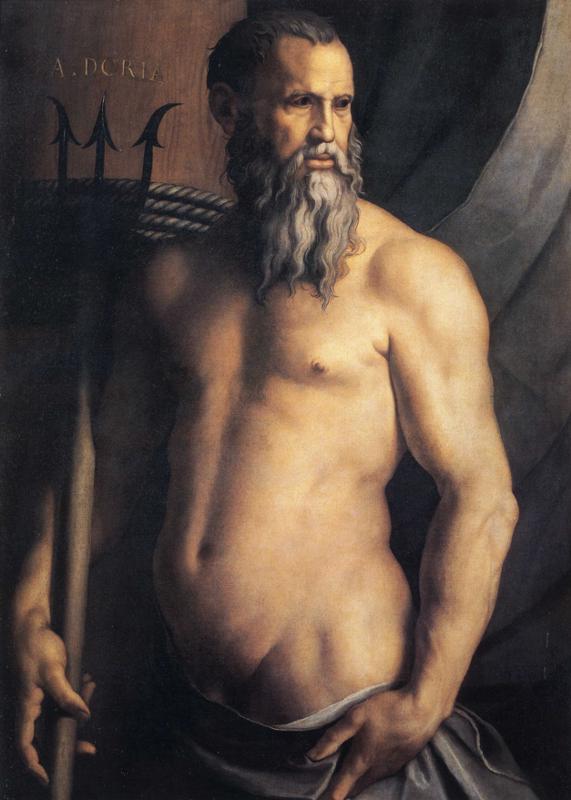Agnolo Bronzino. Portrait of Andrea Doria as Neptune. Oil on canvas. 115 x 53 cm. c.1532-3 or after 1545. Pinacoteca di Brera, Milan, Italy.
Andrea Doria was an Italian mercenary warlord, or condotierre, from Genoa. He was born in the town of Oneglia on November 30, 1466, to Ceva and Caracosa Doria, the lord of the town and his wife. After losing both his parents he became a professional mercenary and, due to his somewhat noble descent, was quickly hired, first into the ranks of the Papal Guard, and then by various Italian noblemen.
He gained fame as an able admiral after siding with Genoa in its revolt against French rule, which was overthrown in no small part thanks to his commanding efforts at sea. He remained in employment of Genoa for several years afterwards, enforcing Italian control over the Mediterranean and waging war against the Ottoman Turks and all manner of pirates, until Genoa was again conquered by the French and then the Holy Roman Empire.
Initially siding with the French, and helping them break the siege of Marseille and then retake Genoa once again, Andrea was disappointed with the French King Francis I for delaying the payments owed him, as well as withholding on returning the seaport of Savona to the Genoese as promised. However, despite his resentment of the king, Andrea waited until the expiration of his contract before changing sides and entering service of Emperor Charles V.
Under the Holy Roman Empire, Andrea wrested control of Genoa away from the French and rewrote the city’s constitution, placing several noble families into power, among these many imperial families, as well as his own. This effectively put an end to the unending squabbles between many contesting factions vying for control of the city, and reestablished the Republic of Genoa as a pseudo-independent state under protection of the Holy Roman Empire. Despite widespread popular approval and support, Andrea declined positions as lord or doge of Genoa, instead assuming the more modest, but still very influential, position of perpetual censor. He was titled Liberator and Father of his Country (Liberator et Pater Patriae) and enjoyed many privileges.
Afterwards Andrea continued to serve as an imperial admiral, helping Charles V conquer all of Italy and even wrestle Tunis from Ottoman control. However, after the Battle of Preveza in September 1538, in which the Holy League’s navy (consisting of Spain, Venice, the Holy Roman Empire, the Papal States and Knights Hospitaller), commanded by Andrea, suffered defeat at the hands of the Turks, the Ottoman Empire secured dominance of the Mediterranean for the next thirty years, and Andrea’s performance as an admiral never recovered its former glamour.
Although he attempted to retire in 1544 after the Empire and France made peace following the Treaty of Crépy, several attempted coups against his family prevented Andrea from spending the rest of his days in peace. His heir and nephew, Giannettino Doria, was killed in a conspiracy organized by Giovanni Luigi Fieschi in 1547, while another, organized by Giulio Cybo in 1548 threatened to spread the revolt across all of Italy to expel Spanish rule from the peninsula, but was luckily discovered and put down before it could be set in motion. In 1550, tired of the affairs at home, Doria once again took to the seas for another five years.
In 1555 Andrea returned to Genoa for the final time, where he gave his grand-nephew, Giovanni Andrea Doria, command of his fleet. He died peacefully on November 24, 1560, leaving all of his estates to Giovanni.

